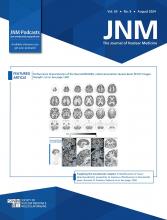Discussions with leaders: Heinrich Schelbert, a pioneer in assessment of cardiac function and a past JNM editor-in-chief, talks with Heiko Schoder and Johannes Czernin about his long career in nuclear medicine.
Page 1163
Effects of 177Lu dose conversion method: Brosch-Lenz and members of the SNMMI 177Lu dosimetry challenge continue their evaluation of sources contributing to variability in dosimetry workflow and calculation of absorbed dose.
Page 1166
Ending the LNT model: Doss explores factors contributing to the persistence of the linear no-threshold model and offers a suggestion for resolving this contentious and long-standing issue.
Page 1173
Radioembolization of NENs: Watanabe and colleagues report on the potential of multicompartment dosimetry in 90Y glass microsphere radioembolization of neuroendocrine neoplasms, observing higher response rates and longer progression-free survival with higher doses.
Page 1175
Posttreatment PET/CT in HNSCC: Clement and colleagues evaluate the diagnostic performance of 18F-FDG PET/CT in detecting subclinical recurrence over a 5-y period after treatment for head and neck squamous cell carcinoma.
Page 1181
68Ga-FAPI46 in mesothelioma: Kessler and colleagues characterize the association of histopathologic FAP expression and 68Ga-FAPI46 PET uptake in malignant mesothelioma and compare resulting sensitivity, specificity, positive/negative predictive values, and detection rates with those of 18F-FDG PET/CT and contrast-enhanced CT.
Page 1188
PET/CT and prognosis in anal cancer: Combet-Curt and colleagues document the predictive value of 18F-FDG PET/CT in terms of recurrence-free, colostomy-free, and overall survival after radiation therapy of squamous cell carcinoma of the anus, including baseline and posttherapeutic imaging.
Page 1194
PRECISE-MDT study: Bauckneht and colleagues assess the impact of different imaging modalities on guidance of metastasis-directed therapy and resulting effects on oncologic outcomes within a large, multiinstitutional cohort of patients with oligorecurrent prostate cancer.
Page 1202
PSMA PET with HOXB13 profiling: Angappulige and colleagues investigate whether SUVs on PSMA PET correlate with expression of Homeobox 13, an oncogenic transcription factor that promotes resistance to androgen receptor–targeted therapies in prostate cancer.
Page 1210
FAP in glioblastoma and gliosarcoma: Oster and colleagues explore the clinical relevance of FAP expression in gliosarcoma and glioblastoma and the diagnostic and therapeutic implications of the ways in which this expression correlates with 68Ga-FAP inhibitor–46 PET uptake.
Page 1217
SIRT AD and spatial liver function: Lu and colleagues identify correlations between 90Y PET absorbed dose voxel maps and nontumoral changes in regional liver function derived from dynamic MRI before and after selective internal radiation therapy.
Page 1224
VIOLET trial protocol: Buteau and colleagues report on a planned phase I/II trial to determine whether [161Tb]Tb-PSMA-I&T can deliver effective radiation to sites of metastatic prostate cancer with an acceptable safety profile.
Page 1231
[18F-Flotufolastat PET/CT reader agreement: Kuo and colleagues document inter- and intrareader reproducibility of 18F-flotufolastat PET/CT scans from 2 phase 3 studies in patients with newly diagnosed and recurrent prostate cancer.
Page 1239
Biomarker for 177Lu-DOTATATE–induced leukopenia: Steinhelfer and colleagues identify spleen volume reduction as a reliable and independent predictor of long-term leukopenia risk after peptide receptor radionuclide therapy.
Page 1244
Radiopharmaceuticals targeting NTSR-1: Fonseca Cabrera and colleagues use multiamine macrocyclic moieties as linkers or chelators in theranostic tracers targeting the neurotensin receptor-1, with a goal of achieving elevated tumor uptake, minimal background interference, and prolonged tumor retention.
Page 1250
FAP-targeted radiopharmaceutical therapy: Mukkamala and colleagues detail the design, development, and preclinical evaluation of a new FAP-targeted radioligand incorporating optimal features of 3 previous therapies and offering high tumor–to–healthy-tissue ratios.
Page 1257
Metaanalysis of [177Lu]Lu-PSMA dosimetry: Ells and colleagues conduct a systematic review and metaanalysis comparing dosimetry methods for the most frequently used [177Lu]Lu-PSMA radiopharmaceutical therapy compounds.
Page 1264
STP [177Lu]Lu-PSMA dosimetry: Resch and colleagues compare different single-time-point approaches in radionuclide therapy dosimetry using multiple-time-point protocols as references and call for greater standardization to facilitate reliable STP dosimetry.
Page 1272
Myocardial somatostatin PET uptake: Larive and colleagues research factors associated with detection of myocardial uptake on somatostatin PET scans recorded for oncology indications and differential PET criteria that characterize myocardial uptake in acute myocarditis patients.
Page 1279
[18F]MFBG LAFOV PET/CT in neuroblastoma: Borgwardt and colleagues detail experience with a long-axial-field-of-view PET/CT system and this new tracer in children with neuroblastoma, noting shorter scan times, higher sensitivity, and avoidance of general anesthesia or sedation.
Page 1286
Noninvasive imaging of olfaction: Adilbay and colleagues describe preclinical and human tissue studies on the use of Tsp1a-IR800P, a novel fluorescent probe, as a tool to diagnose loss of smell by selectively targeting NaV1.7 expression in olfactory epithelium.
Page 1293
Bimodal guidance in hepatobiliary surgery: Rietbergen and colleagues summarize development and preclinical studies with 99mTc-hHEPATO-Cy5, a bimodal tracer that facilitates both fluorescence guidance and radioguidance in surgical resection of deep hepatic lesions.
Page 1301
“Explainable” radiomics: Captier and colleagues introduce a model- and modality-agnostic tool that explains predictions of multiregion radiomic models by highlighting the contribution of each individual region.
Page 1307
HMC algorithm for uMI Panorama: Kang and colleagues validate Neurofocus, a head motion–correction algorithm for the uMI Panorama PET/CT system, using a data-driven, statistics-based approach.
Page 1313
NeuroEXPLORER performance: Li and colleagues provide the physical characteristics, performance evaluation, and first human images with the NeuroEXPLORER, a dedicated brain PET imager with high spatial resolution, high sensitivity, and a 3D camera for markerless continuous motion tracking.
Page 1320
Off-target effects of enzalutamide: Bauckneht and colleagues compare brain metabolism in patients with metastatic castration-resistant prostate cancer with and without enzalutamide treatment.
Page 1327
False-positive FAPI PET after therapy: Ludwig and colleagues offer an illustrative case study in a patient with lingering [68Ga]Ga-FAPI uptake in postchemotherapy fibronecrotic tissue and urge caution in interpretation of posttherapy residual lesions.
Page 1328
- © 2024 by the Society of Nuclear Medicine and Molecular Imaging.







